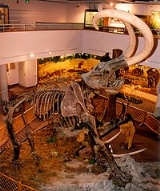
Mammoth
Overview
A mammoth is any species
of the extinct genus
Mammuthus. These proboscidea
ns are members of Elephantidae
, the family of elephants and mammoths, and close relatives of modern elephants. They were often equipped with long curved tusks and, in northern species, a covering of long hair
. They lived from the Pliocene
Epoch
from around 4.8 million years ago, into the Holocene
at about 4,500 years ago. The word mammoth comes from the Russian
mamont, probably in turn from the Vogul (Mansi) language
, mang ont, meaning "earth horn".
Like their modern relative the elephant (Asian or African), mammoths were quite large; in English the noun "mammoth" has become an adjective meaning "large" or "massive".
Species
In biology, a species is one of the basic units of biological classification and a taxonomic rank. A species is often defined as a group of organisms capable of interbreeding and producing fertile offspring. While in many cases this definition is adequate, more precise or differing measures are...
of the extinct genus
Genus
In biology, a genus is a low-level taxonomic rank used in the biological classification of living and fossil organisms, which is an example of definition by genus and differentia...
Mammuthus. These proboscidea
Proboscidea
Proboscidea is a taxonomic order containing one living family, Elephantidae, and several extinct families. This order was first described by J. Illiger in 1881 and encompasses the trunked mammals...
ns are members of Elephantidae
Elephantidae
Elephantidae is a taxonomic family, collectively elephants and mammoths. These are terrestrial large mammals with a trunk and tusks. Most genera and species in the family are extinct...
, the family of elephants and mammoths, and close relatives of modern elephants. They were often equipped with long curved tusks and, in northern species, a covering of long hair
Hair
Hair is a filamentous biomaterial, that grows from follicles found in the dermis. Found exclusively in mammals, hair is one of the defining characteristics of the mammalian class....
. They lived from the Pliocene
Pliocene
The Pliocene Epoch is the period in the geologic timescale that extends from 5.332 million to 2.588 million years before present. It is the second and youngest epoch of the Neogene Period in the Cenozoic Era. The Pliocene follows the Miocene Epoch and is followed by the Pleistocene Epoch...
Epoch
Epoch (geology)
An epoch is a subdivision of the geologic timescale based on rock layering. In order, the higher subdivisions are periods, eras and eons. We are currently living in the Holocene epoch...
from around 4.8 million years ago, into the Holocene
Holocene
The Holocene is a geological epoch which began at the end of the Pleistocene and continues to the present. The Holocene is part of the Quaternary period. Its name comes from the Greek words and , meaning "entirely recent"...
at about 4,500 years ago. The word mammoth comes from the Russian
Russian language
Russian is a Slavic language used primarily in Russia, Belarus, Uzbekistan, Kazakhstan, Tajikistan and Kyrgyzstan. It is an unofficial but widely spoken language in Ukraine, Moldova, Latvia, Turkmenistan and Estonia and, to a lesser extent, the other countries that were once constituent republics...
mamont, probably in turn from the Vogul (Mansi) language
Mansi language
The Mansi language is a language of the Mansi people. It is spoken in territories of Russia along the Ob River and its tributaries, including the Khanty-Mansi Autonomous Okrug and the Sverdlovsk Oblast...
, mang ont, meaning "earth horn".
Like their modern relative the elephant (Asian or African), mammoths were quite large; in English the noun "mammoth" has become an adjective meaning "large" or "massive".
Discussions

